Medical Disclaimer: This article is for informational purposes only and does not replace professional veterinary advice. If your dog is having difficulty breathing, contact your veterinarian immediately.
Table of Contents
If your dog is breathing heavier than usual, you’re not alone in feeling alarmed. As a veterinarian, I’ve seen many loving owners rush in, worried about their dog’s rapid or labored breathing. While panting is often normal, especially after a walk or in warm weather, heavy breathing in dogs can also point to more serious dog respiratory issues from heart disease to lung conditions.
Recognizing when this symptom is harmless versus when it’s an emergency can literally save your dog’s life. In this guide, you’ll learn the causes, warning signs, and what treatments are available plus when to call your vet. Whether you’re a first-time pet parent or seasoned dog owner, understanding heavy breathing in dogs is key to keeping your pet safe and healthy.
Key Takeaways
- Heavy breathing in dogs can range from normal panting to signs of serious dog respiratory issues like pneumonia, heart disease, or airway collapse.
- Common symptoms include rapid or labored breathing at rest, coughing, blue gums, or reluctance to move.
- Immediate vet care is needed if breathing is noisy, persistent, or paired with other distress signs.
- Diagnosing the cause often requires X-rays, bloodwork, or oxygen monitoring.
- Treatments may include oxygen therapy, medications, or surgery depending on the cause.
- You can reduce your dog’s risk with parasite prevention, regular checkups, and monitoring breathing at home.
What Is Considered Heavy Breathing in Dogs?
Also see: https://doglifeexpert.com/2025-dog-teeth-cleaning-without-anesthesia/
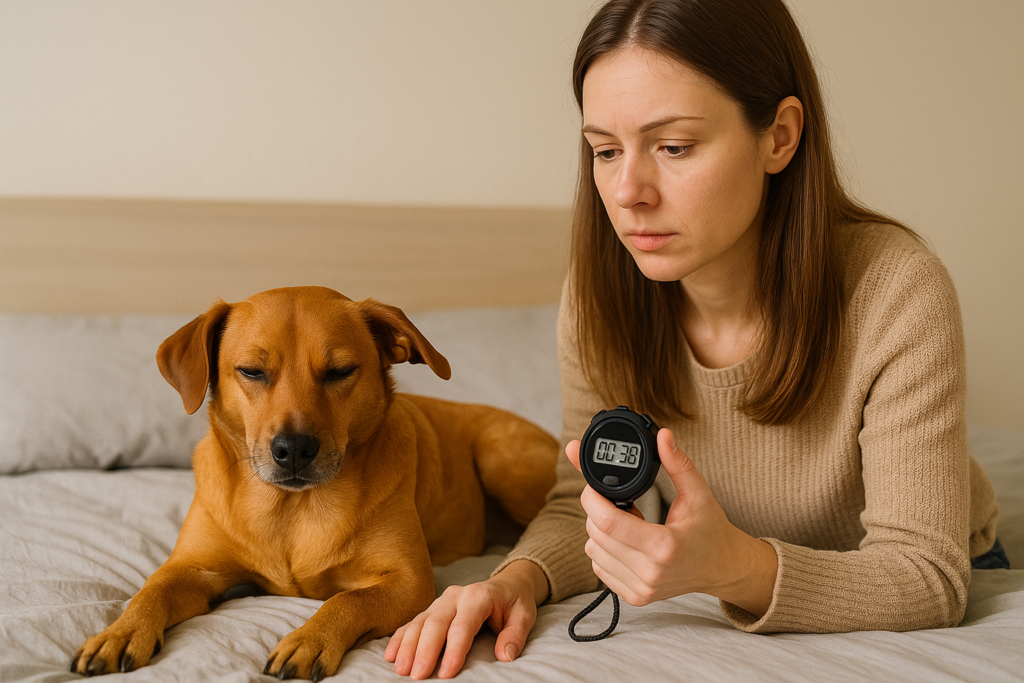
Heavy breathing in dogs goes beyond normal panting after play or heat exposure. It’s typically defined as an increase in breathing rate, effort, or noise that’s abnormal for the dog’s condition. While some dog respiratory issues may present subtly, others escalate quickly.
Normal vs. Abnormal Breathing
- Normal: 10–35 breaths per minute at rest (puppies may be slightly higher)
- Heavy Breathing: >35 breaths per minute at rest or shallow, effortful, open-mouthed breathing
Quick At-Home Breathing Check
- Watch your dog when fully relaxed or sleeping.
- Count how many times their chest rises in 30 seconds.
- Multiply by 2 to get breaths per minute.
- Anything above 35 should prompt monitoring especially if it occurs often.
If your dog is breathing fast with belly effort, wheezing, or nasal flaring, these are classic signs of dog respiratory issues and need vet attention.
Top 8 Vet-Identified Causes of Heavy Breathing in Dogs
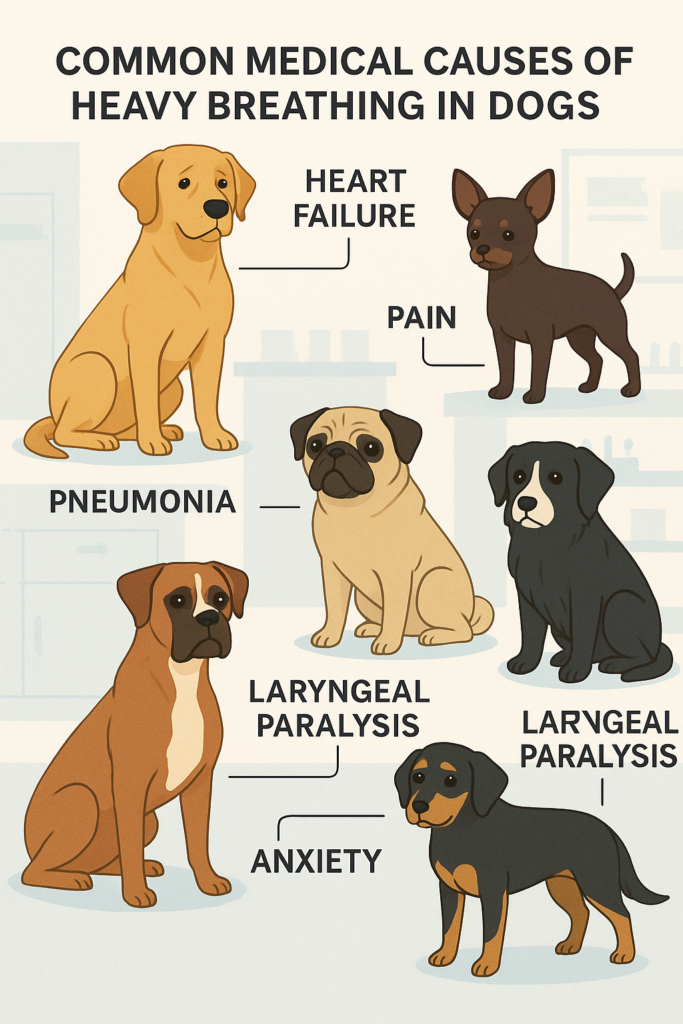
As a practicing veterinarian, I often see cases of heavy breathing in dogs related to one of eight primary conditions. These can range from treatable infections to life-threatening emergencies. Here’s a closer look:
| Cause | Description | Symptoms | Typical Canadian Cost |
|---|---|---|---|
| Left-Sided Heart Failure | The heart struggles to pump blood efficiently, causing fluid in the lungs. | Shallow, rapid breathing, coughing, fatigue | $300–$1,200 (diagnostics + meds) |
| Pain | Pain from injury, illness, or surgery triggers stress-induced heavy breathing. | Restlessness, panting, reluctance to move | $150–$500 |
| Pneumonia | Bacterial, viral, or fungal lung infections cause fluid and inflammation. | Cough, fever, discharge from nose/eyes, lethargy | $400–$1,500 |
| Chronic Bronchitis | Persistent airway inflammation makes breathing laborious over time. | Chronic cough, wheezing, exercise intolerance | $250–$800 |
| Heartworm Disease | Parasites clog the lungs and heart, impairing breathing. | Coughing, fatigue, heavy breathing | $600–$1,800 (prevention <$20/mo) |
| Cancers | Tumors in the lungs or airways can obstruct airflow. | Labored breathing, weight loss, low energy | $1,000–$5,000+ |
| Lung Bulla | Air pockets that rupture and collapse lung tissue—emergency situation. | Sudden distress, shallow breathing | $1,200–$3,000 (surgery likely) |
| Lungworm | Parasitic larvae damage airways, especially in young or outdoor dogs. | Coughing, reduced appetite, labored breathing | $300–$700 (easily preventable) |
Many of these conditions involve dog respiratory issues that worsen over time if untreated. Prompt diagnosis improves outcomes significantly.
Other Medical Causes to Know
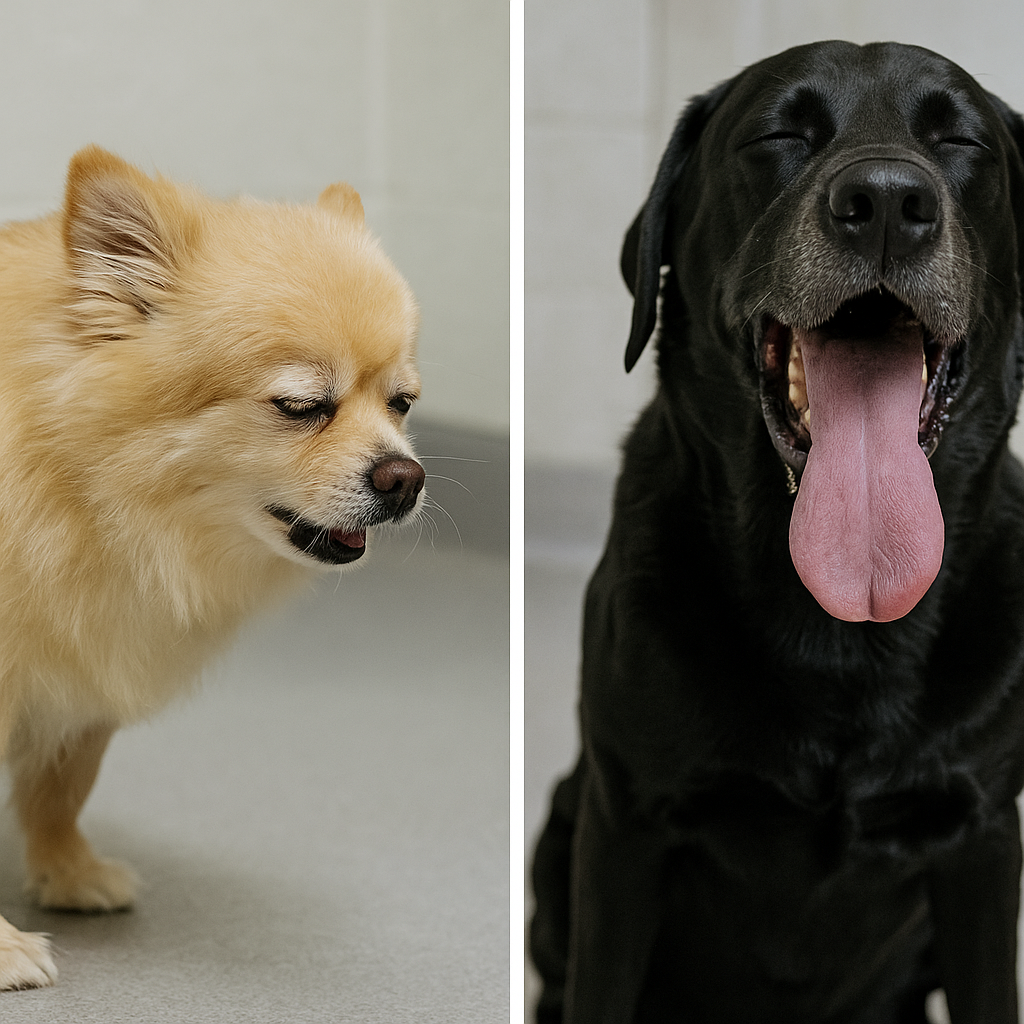
While the top 8 causes are common, several lesser-known conditions can also lead to heavy breathing in dogs. These often overlap with dog respiratory issues, making a veterinary diagnosis essential.
Heart and Lung Conditions
- Pulmonary Hypertension: High pressure in lung arteries strains the heart. Dogs may breathe fast, tire easily, or faint.
- Pulmonary Contusions: Bruising from trauma (e.g., car accidents) can restrict lung function.
- Noncardiogenic Pulmonary Edema: Fluid in lungs due to toxins, electrocution, or near-drowning—not heart-related.
Airway and Structural Disorders
- Laryngeal Paralysis: The voice box fails to open fully, causing noisy, effortful breathing especially in Labradors and senior dogs.
- Tracheal Collapse: The windpipe flattens during breathing, causing a “goose-honk” cough and labored breaths. Small breeds like Yorkies are most affected.
- Pleural Effusion/Pneumothorax: Fluid or air around the lungs compresses them. Vets can drain this, often under sedation.
Infectious & Inflammatory Diseases
- Kennel Cough (Bordetella): A dry, hacking cough worsens into wheezing or heavy breathing in dogs.
- Asthma (Rare in Dogs): More common in cats, but allergic bronchitis can mimic asthma-like symptoms.
- Chronic Bronchitis: Ongoing inflammation leads to progressive dog respiratory issues, requiring long-term care.
Non-Respiratory Causes
- Heatstroke: A top summer emergency. Dogs can’t sweat panting is their cooling system. If ineffective, body temp soars dangerously.
- Anemia: Fewer red blood cells = less oxygen delivery = increased breathing effort.
- Cushing’s Disease: High cortisol levels lead to abdominal fat, muscle loss, and heavy breathing in dogs.
- Stress or Anxiety: Panting and pacing during fireworks or vet visits is common but should ease with calm.
Because so many systems affect breathing, ruling out one cause often requires testing for another. That’s why catching dog respiratory issues early is so important.
Symptoms of Abnormal Breathing in Dogs
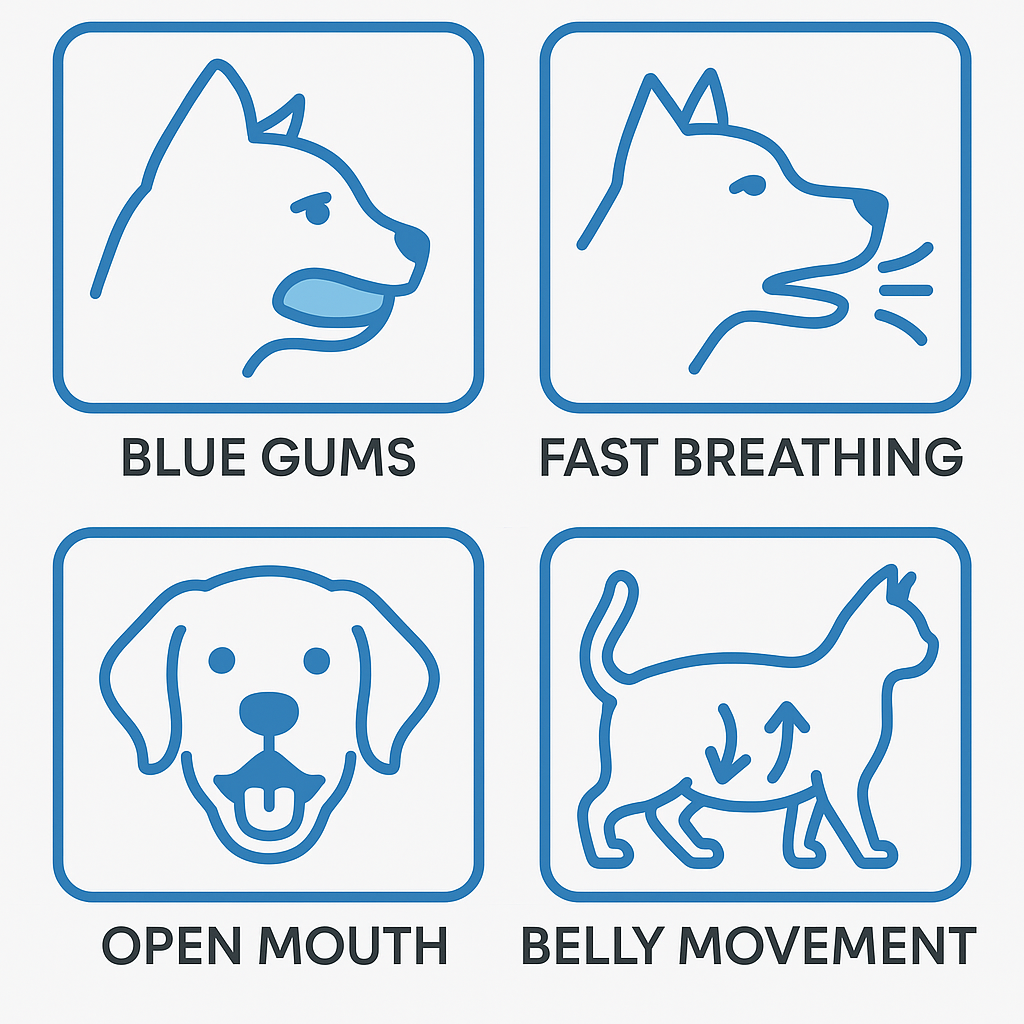
Not all heavy breathing in dogs looks the same. Some signs are subtle; others are true emergencies. Understanding what to look for can help you act quickly.
Common Signs of Dog Respiratory Issues
- Rapid Breathing at Rest: Over 35 breaths per minute when calm
- Labored Breathing: Visible belly or chest effort to inhale or exhale
- Noisy Breathing: Wheezing, high-pitched stridor, or snoring-like stertor
- Open-Mouthed Breathing: Not normal unless your dog is hot or active
- Breathing from the Belly: Suggests respiratory distress or diaphragm pressure
- Shallow or Ineffective Breaths: Can indicate oxygen deprivation
- Blue, Purple, or Pale Gums: EMERGENCY lack of oxygen
- Coughing or Gagging: Often linked to bronchitis, pneumonia, or heart issues
- Foam or Fluid from Nose or Mouth: Late-stage distress
- Restlessness or Pacing: Common in painful or anxious dogs
- Stiff Posture or Neck Extended: Trying to open the airway for more oxygen
- Lethargy or Refusal to Move: Exhaustion from breathing effort
- Avoiding Lying Down: Lying flat worsens breathing in some cases
Any combination of these symptoms may suggest dog respiratory issues that need urgent veterinary attention.
When to See a Vet And When It’s an Emergency

Knowing when heavy breathing in dogs requires veterinary attention can be life-saving. Some causes are benign, but others can escalate rapidly.
Normal Situations
- After play, walks, or excitement
- In hot weather (if it resolves quickly)
- Brief stress events (like vet visits or fireworks)
These should improve with rest, cooling, or comfort within minutes. If your dog continues to breathe heavily long after the event, it’s no longer normal.
When to Call Your Vet
- Persistent fast breathing at rest
- Coughing that doesn’t go away
- Occasional wheezing or gagging
- Trouble settling down to sleep
- Recurring episodes, especially overnight
Emergency Red Flags 🚨
- Blue or purple tongue or gums
- Open-mouthed breathing when calm
- Collapse or fainting
- Wide stance or stretching neck forward
- Unwillingness to lie down due to breathing
Dr. Brad Hinsperger of Kingsdale Animal Hospital warns, “If your dog is breathing heavily and showing signs of distress, don’t wait—head to your vet or an emergency clinic immediately.”
5-Minute At-Home Checklist
Before calling your vet, jot down:
- Breathing rate (at rest)
- Time of onset
- Any coughing, vomiting, or unusual behavior
- Exposure to heat, trauma, toxins, or strenuous activity
- Video of your dog’s breathing (vets find this very helpful)
Understanding these signs helps distinguish harmless panting from serious dog respiratory issues.
How Vets Diagnose Heavy Breathing in Dogs
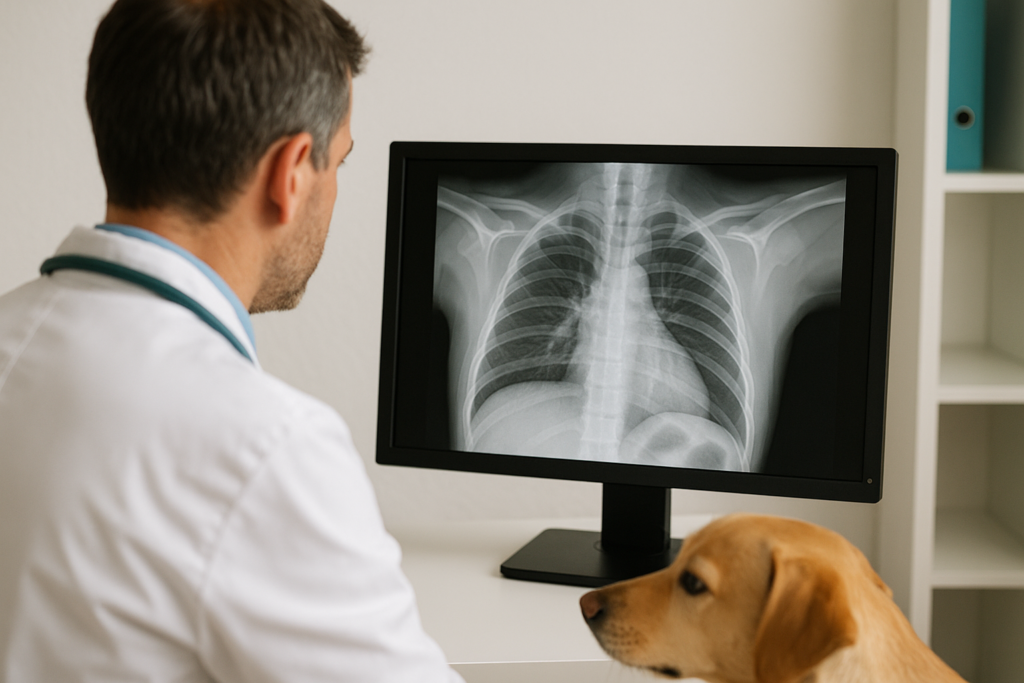
When a dog comes in with breathing concerns, we use a combination of exams and diagnostic tools to pinpoint the cause. Because heavy breathing in dogs can stem from many sources, a thorough workup is essential.
Step-by-Step Veterinary Approach
- Physical Exam
We listen to the heart and lungs, check gum color, and observe breathing patterns. - Diagnostic Tests
Depending on your dog’s symptoms, your vet may recommend:- Blood Work: To detect infections, anemia, or organ dysfunction
- X-rays (Chest/Abdomen): To visualize the lungs, heart, trachea, or tumors
- Ultrasound: Especially useful for heart or abdominal causes
- Electrocardiogram (ECG): Checks for arrhythmias or heart disease
- Pulse Oximetry: Estimates blood oxygen saturation
- Arterial Blood Gas Analysis: Accurately measures oxygen and CO₂ levels
- Bronchoscopy: Allows direct viewing of the airways (requires sedation)
- Advanced Imaging or Procedures
- CT Scan or MRI: For tumors or complex structural issues
- Fluoroscopy: Real-time X-ray for collapsing trachea or dynamic airway collapse
At my Ottawa clinic, I’ve used a combination of chest X-rays and ECG to diagnose heart failure in senior dogs and guided urgent care based on those results. Timely diagnostics are critical for managing dog respiratory issues effectively.
Treatment Options for Heavy Breathing in Dogs
Treatment depends entirely on the cause of your dog’s breathing problems. Once a vet identifies the source, they’ll tailor a plan to ease symptoms and address the underlying issue. Whether it’s infection, heart disease, or airway obstruction, managing heavy breathing in dogs requires precision and often immediate care.
Emergency Stabilization
- Oxygen Therapy: Administered via face mask or oxygen cage in-clinic
- Cooling Measures: Essential for dogs with heatstroke
- IV Fluids: Helps treat shock, dehydration, or severe infection
Medications
- Heart Conditions:
- Furosemide (diuretic) to remove lung fluid
- Enalapril or pimobendan to improve heart efficiency
(More on canine heart meds →)
- Infections:
- Antibiotics for bacterial pneumonia
- Antifungals for fungal infections
- Chronic Conditions:
- Bronchodilators (e.g., theophylline) for bronchitis
- Corticosteroids for inflammation or allergic reactions
- Pain Relief:
- NSAIDs like carprofen for post-op or injury-related pain
- Parasites:
- Heartworm preventives (e.g., ivermectin)
- Anthelmintics for lungworms
Surgical or Procedural Options
- Laryngeal Paralysis: “Tie-back” surgery to open the airway
- Tracheal Collapse: Stenting or surgery in severe cases
- Tumors or Masses: Surgical removal or biopsy
- Pleural Effusion: Chest tube placement to drain fluid
Lifestyle & Long-Term Management
- Weight loss to reduce airway compression
- Limit activity during hot/humid weather
- Anxiety medications if stress-induced dog respiratory issues are recurrent
- In-home oxygen tanks or nebulizers for chronic disease (under vet guidance)
Every treatment plan is customized. What’s critical is recognizing symptoms early and getting your dog into care before things escalate.
How to Prevent Breathing Problems in Dogs
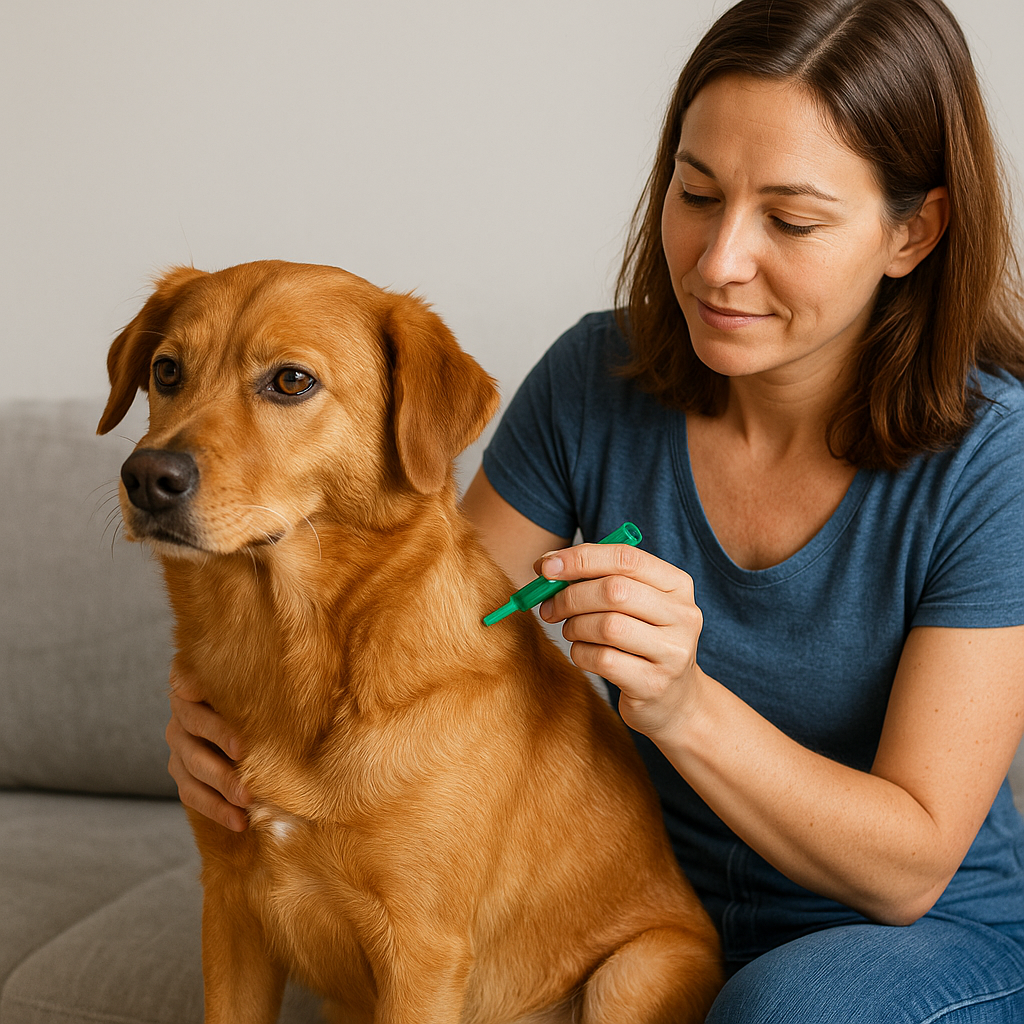
While not every case of heavy breathing in dogs is preventable, many risk factors can be reduced through good care and awareness. Preventing dog respiratory issues starts with proactive habits and regular veterinary oversight.
5-Minute Home Prevention Checklist
✅ Count your dog’s resting breaths weekly
✅ Keep your pet’s weight in a healthy range
✅ Use parasite preventatives year-round
✅ Avoid intense activity in hot/humid weather
✅ Watch for coughing or noisy breathing
✅ Reduce household stress (no yelling, calm routines)
✅ Ensure clean, ventilated sleeping areas
Vet-Recommended Preventive Tips
- Heartworm & Lungworm Protection: Use monthly parasite control (e.g., Interceptor®) especially if you hike or live in rural areas.
- Annual Vet Exams: Early detection of heart murmurs or chronic bronchitis allows early treatment.
- Dental Hygiene: Infections in the mouth can travel to the lungs.
- Avoid Smoke or Irritants: Cigarette smoke, aerosols, or strong cleaning chemicals can trigger airway inflammation.
- Cool, Calm Spaces: Dogs with short noses (like Pugs or Bulldogs) need A/C and stress-free environments to avoid breathing crises.
Preventive care significantly lowers the chance of emergency visits for heavy breathing in dogs.
Real Vet Case Example: A Labrador with Hidden Heart Disease
One of the more memorable cases of heavy breathing in dogs I’ve seen involved an 11-year-old Labrador named Max. His owner brought him in on a warm June morning because he had been breathing heavily overnight and refused breakfast unusual for a Labrador.
Max’s breathing rate at rest was 52 per minute, and he showed mild gum paleness. An X-ray revealed fluid in his lungs, and our in-clinic ECG showed a heart enlargement consistent with left-sided congestive heart failure. We admitted him immediately, started oxygen therapy, and gave furosemide to remove the fluid.
Within hours, Max was breathing easier. He went home 48 hours later with medications and a new low-sodium diet. With regular monitoring and adjusted medication, Max lived comfortably for over a year.
His case is a reminder that dog respiratory issues don’t always come on suddenly but once they’re visible, quick action matters.
FAQ – People Also Ask
Why is my dog breathing fast but not panting?
This may signal early dog respiratory issues such as heart disease, pain, or anemia. If your dog is breathing rapidly at rest without signs of heat or exercise, consult your vet.
Is heavy breathing in older dogs normal?
No. While some senior dogs pant more due to age-related changes, heavy breathing in dogs especially when at rest—can indicate conditions like heart failure, arthritis pain, or cancer.
Can anxiety cause heavy breathing in dogs?
Yes. Stress or fear can trigger panting and fast breathing. However, if this persists when the dog is calm, it could be more than anxiety.
What is a normal breathing rate for dogs at rest?
Between 10–35 breaths per minute. Anything consistently over 35, especially without activity, should be evaluated by a veterinarian.
When should I take my dog to emergency for breathing?
Immediately, if you notice blue gums, open-mouth breathing, collapse, or a wide-legged stance. These are signs of life-threatening dog respiratory issues.
Do brachycephalic breeds (like Bulldogs) breathe differently?
Yes. Their short skulls restrict airflow, making them prone to heavy breathing in dogs especially in heat or during activity. Monitor these breeds closely and avoid overexertion.
Final Thoughts from a Canadian Vet
Heavy breathing in dogs isn’t something to ignore it’s your pet’s way of telling you something isn’t right. Whether it’s a temporary reaction to stress or a symptom of a serious heart or lung condition, your awareness can make all the difference.
From my practice in Ottawa, I’ve seen firsthand how early intervention can turn scary situations around. Know your dog’s normal breathing pattern. Take videos of anything unusual. Keep regular checkups, especially for senior dogs or breeds prone to dog respiratory issues like Bulldogs or Yorkies.
Finally, don’t hesitate to call your vet. When it comes to your dog’s breathing, it’s always better to be safe than sorry.

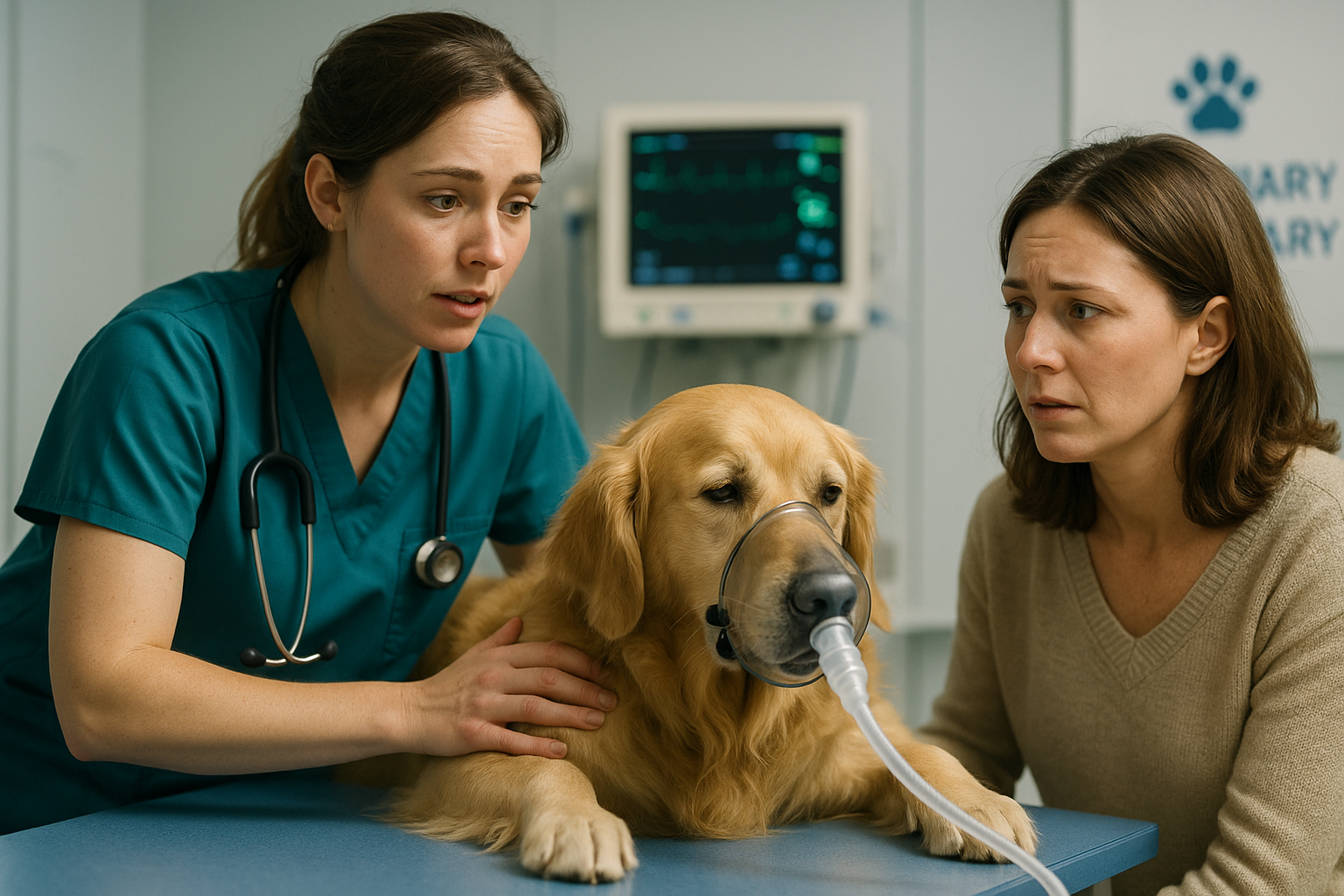

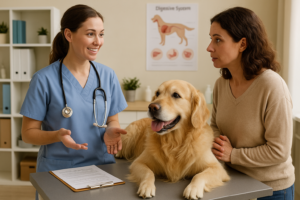
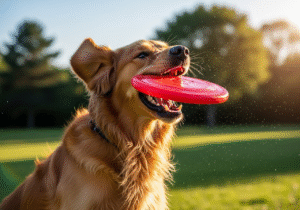
Pingback: Elementor #2203 - Dog Life Expert
Pingback: "Avocado Oil for Dogs: 2025 Best Vet Guide to Benefits, Risks & Safer Oils"